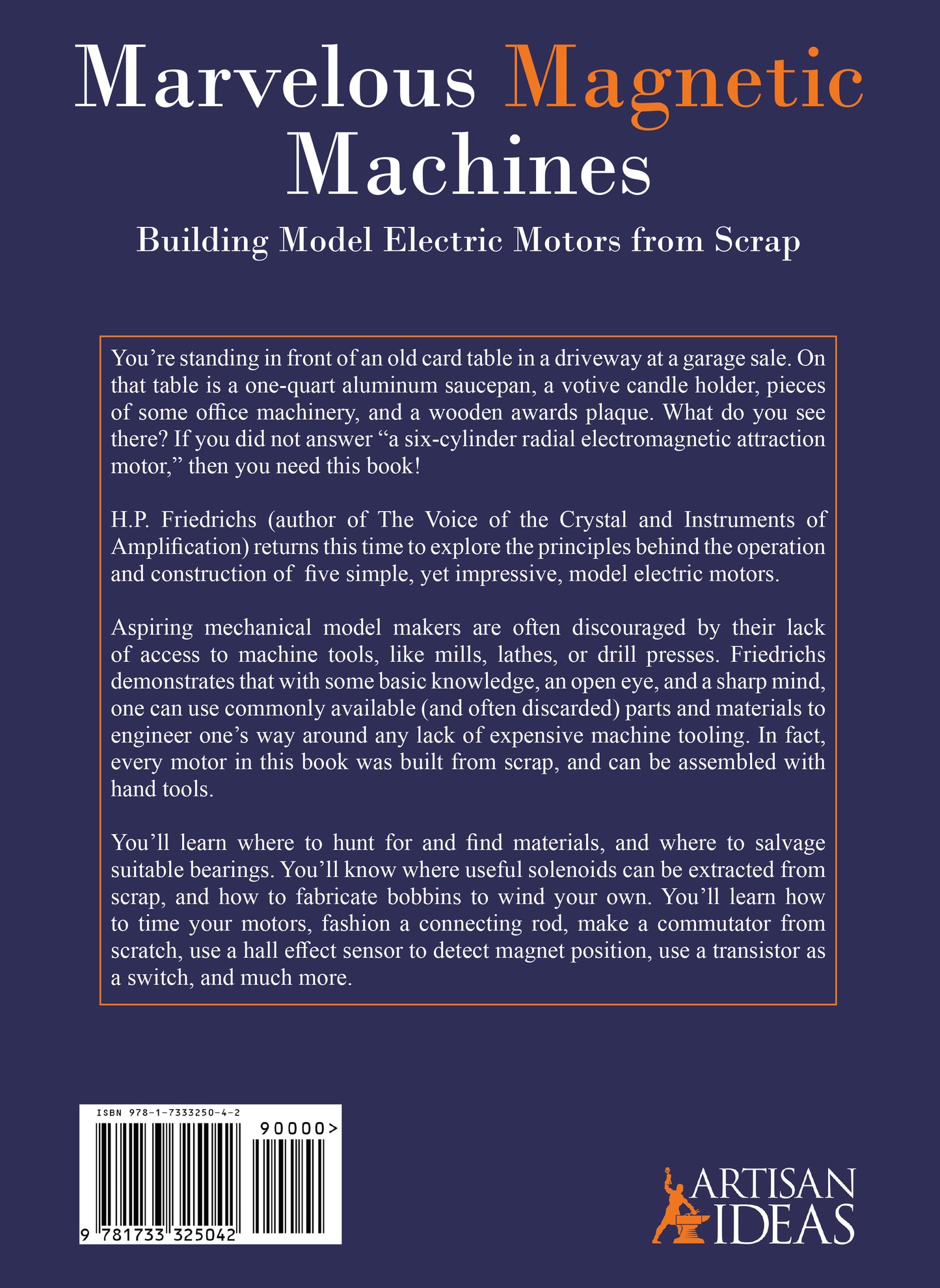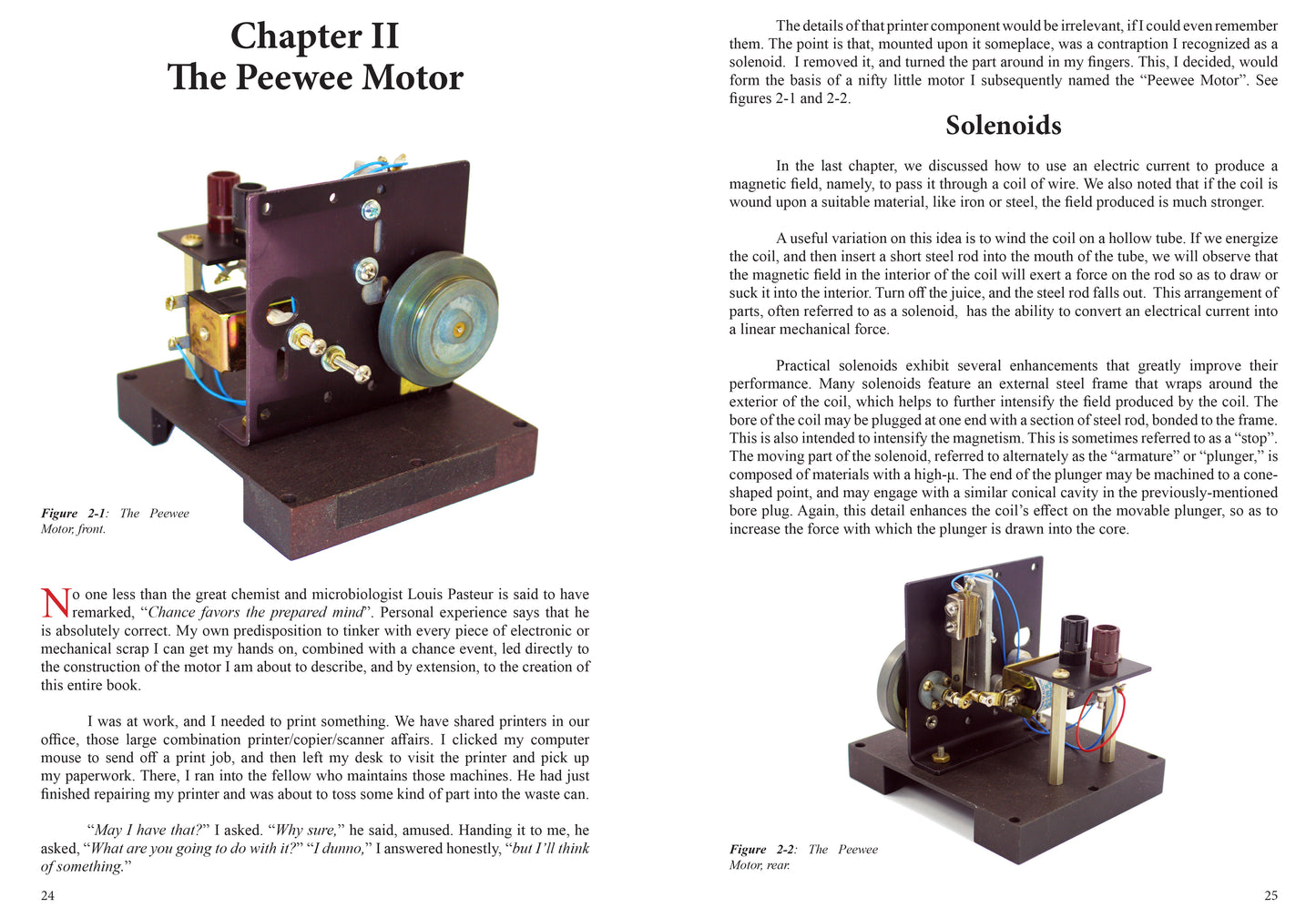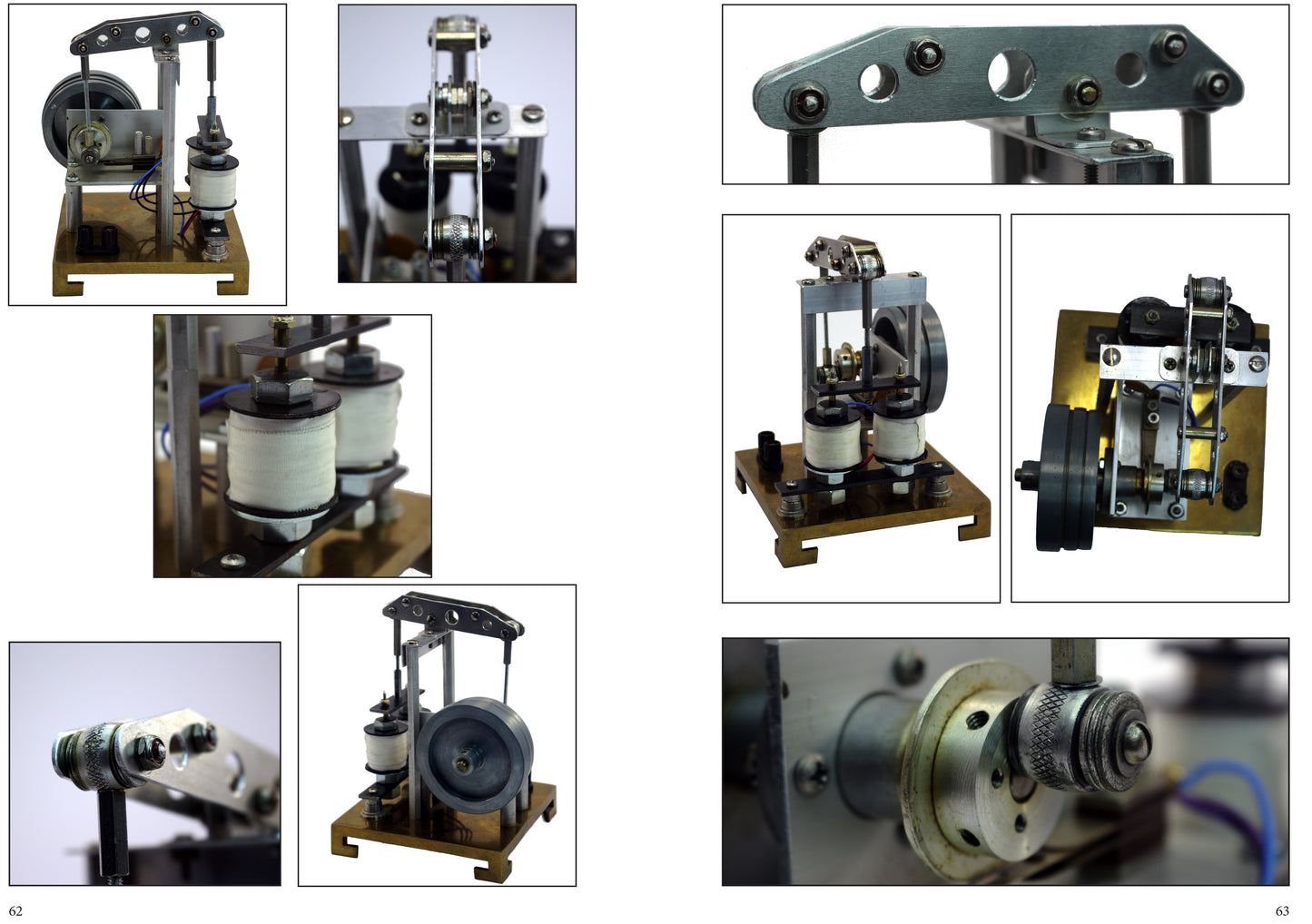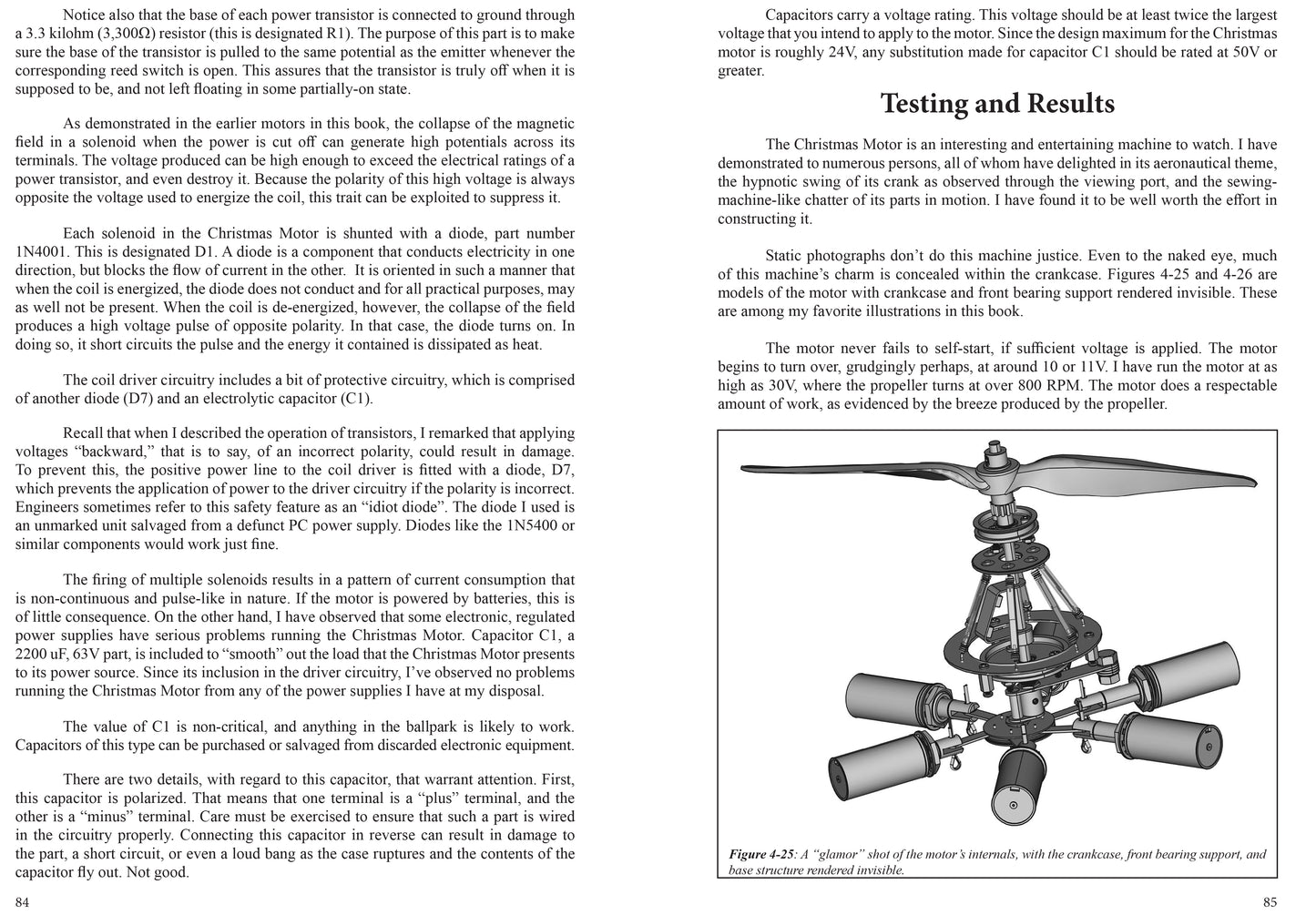Marvelous Magnetic Machines
Marvelous Magnetic Machines
Couldn't load pickup availability
View full details
Winner of the Gold Medal for the best HOBBY and CRAFT BOOK 2022, IBPA Book Awards.
This is an absolutely delightful, entertaining and educational read for anyone interested in science, mechanics, electronics, amateur radio, tinkering, or simply "how things work".
From the back cover:
"You’re standing in front of an old card table in a driveway at a garage sale. On that table is a one-quart aluminum saucepan, a votive candle holder, pieces of some office machinery, and a wooden awards plaque. What do you see there? If you did not answer “a six-cylinder radial electromagnetic attraction motor,” then you need this book!"
H.P. Friedrichs (author of The Voice of the Crystal and Instruments of Amplification) returns this time to explore the principles behind the operation and construction of five simple, yet impressive, model electric motors.
Aspiring mechanical model makers are often discouraged by their lack of access to machine tools, like mills, lathes, or drill presses. Friedrichs demonstrates that with some basic knowledge, an open eye, and a sharp mind, one can use commonly available (and often discarded) parts and materials to engineer one’s way around any lack of expensive machine tooling. In fact, every motor in this book was built from scrap, and can be assembled with hand tools.
You’ll learn where to hunt for and find materials, and where to salvage suitable bearings. You’ll know where useful solenoids can be extracted from scrap, and how to fabricate bobbins to wind your own. You’ll learn how to time your motors, fashion a connecting rod, make a commutator from scratch, use a hall effect sensor to detect magnet position, use a transistor as a switch, and much more.
H.P. Friedrichs is a degreed electrical engineer (BSEE), inventor, and author with more than three decades of experience working in domains ranging from audio, medical, and radio, to software, automotive, and aerospace. At present, he is a Principal Engineer with Honeywell, involved in the design and support of specialized equipment used for testing and validating aircraft power generation products.
He has five U.S. patents to his credit and holds three radio licenses including Extra-Class Amateur (AC7ZL), Commercial Radio Operator with Radar Endorsement and GMDSS
Operator/Maintainer with Radar Endorsement. He is also a certified VE.
Friedrichs is the author of numerous technical articles appearing in a variety of magazines, newsletters, and web sites but is best known for his books The Voice of the Crystal and Instruments of Amplification. Now cult classics among "from-scratch" electronics experimenters, these books have enjoyed favorable reviews from the editors of such prestigious periodicals as QST, CQ Magazine, Practical Wireless, and Make Magazine.
H.P. Friedrichs lives in Tucson, Arizona, with his wife and his German Shepherd/laboratory assistant — who is prone to "borrow" books and tools but not return them.
| IBPA Benjamin Franklin Award | 2022 | Winner |
"Motors combine the almost magical property of magnetism with electricity to move the world around us. Many of us like to make things, and use motors in our designs. Mr. H. P. Friedrichs has written a delightful book on how to make five motors that are works of art, and how to do so with scrap materials. They are not necessarily motors that you would use to power something (although they could do this), but are machines of artistic, intricate and interesting construction that are designed to be a delight to watch.
To make these clever creations, we need to understand how motors work. With clear explanation of how electricity and magnetism work together to create the forces that move things, Mr. Friedrichs shows us what is behind the function of these motors that are clearly not from your mother’s sewing machine. He tells us “Build a homemade motor that works, and you’ve demonstrated a certain mastery of a force that, because of its utility, is largely responsible for our present quality of life.”
In the construction of these motors, a number of parts are needed. Instead of giving us a parts list and a recipe to put them together, we are given the knowledge of how to make the parts that are needed, or how to adapt parts that we can obtain from discarded everyday mechanical and electrical devices. I find this information valuable, and helpful to the creation of my own things. A motor made using this book will probably not look just like the pictures, but will reflect the things you learn and the available parts that you adapt from other things. The designs remind me of Thomas Edison’s inventions displayed in his reconstructed laboratory in Greenfield Village in Dearborn, Michigan. The parts have a purpose, but are neatly constructed and arranged to make the mechanism pleasing to look at as well as functional.
We start by learning about the Peewee Motor, a clever little thing that uses a solenoid to drive a flywheel with a mechanical crankshaft linkage. A solenoid is taken from an old copier. A bearing, capstan and flywheel come from an old tape recorder. Places to get these and other parts tell us how many great parts are available if we just know where to look. An old trivet or plaque makes for a handsome display base. On the way during the construction of this motor, we must make provisions for timing of the solenoid’s activation. Plentiful photographs and 3D drawings make it easy to visualize the construction.
Later Mr. Friedrichs expands on that with the Christmas Motor, with six solenoids and more advanced needs in timing and mechanical operation. Where do the parts come from? Mr. Friedrichs describes 17 different sources where ball bearings can be obtained! Take a threaded bushing from an old potentiometer, a support from an old candle holder, an aluminum saucepan for a crankcase, and other parts from the many places that are described and you can get most of the parts you need.
Among my favorites is the “Little Twister” motor: a brushless motor that is based on the principles of the motors in our computer’s cooling fans. So that’s how they work! Parts from an old VCR, an old lamp for the base, and an old candle holder for the flywheel give the project some beautiful parts. Thorough instructions on how to accomplish “jeweling” or “engine turning” of the mounting plate faces gives a nice look to the metal. I know I will use this technique, as it is quite pretty.
This motor has more complexity in the timing, so we learn about Hall Effect sensors and transistors to drive the coils. Although these parts are inexpensive to buy, we learn about sources where they can be salvaged. There is more electronics involved with this motor, and Mr. Friedrichs gives us the knowledge needed to understand what is needed. Then we also have the ability to apply these features to other creations that we might come up with after being inspired by this book.
Because much of this book contains the use of electricity and electronics, Mr. Friedrichs finishes with some good information on the use of electronics. He includes information on power supplies, multimeters and other test instruments. He also has a section on motor balancing. These educational parts round out the book to be an education in electronics and mechanics that the hobbyist who is designing and building things at home will find to be a valuable resource to help him in his endeavors."
"H.P. Friedrichs is a ham who has the Maker spirit: The book title says it all, especially the part about making something from scrap. The title and the cover photo captured my attention right away.
Regular readers of
"The Ham Notebook"
column probably know about my philosophy on buying surplus items, which is, "I don't always buy something for what the object is but rather what the object can become."
Like many of the topics in my column, this book is not a step-by-step, how-to-make it book of projects, but rather a guide to inspire discussion or a springboard for projects of your own and specifically in using magnetism to make electric motors.
The book has a good section on electrical principles and magnetics, including force, distance, and permeability. Remember the "right hand rule" in physics class? (If not look it up!).
The projects are excellent examples of how one can take something from swap meets, garage sales, and junk shops to create something else in an interesting and beautiful way. Making projects using castoffs like this is an excellent example of what I call "pre-cycling" -- preventing trash and other objects from going into the landfill.
Friedrichs and I are kindred spirits. We have many things in common, including an appreciation for Alfred P. Morgan, who wrote
"The Boy's Book of Radio and Electronics" series as well as many other titles; and the book by Paul Horowitz and Winfield Hill called "The Art of Electronics."
As I read the book, I can see their influence in his work.
Interestingly, most of the motors described in this book are based on a linear motion, translating to rotary motion we normally associate with motors. This is something new for me, and I found the concepts interesting. The project descriptions include explanations of the mechanics involved in the translation process, and how to make the systems using scrap materials.
You can watch these motors in action at “https://www.youtube.com/watch?v=BNp-ICvvM1o”. I hope Friedrichs will someday post a revised video of these motors in action without the background music. The solenoids and mechanical linkages must be fascinating to watch and they must make interesting noises
(Publisher’s Note: the author is currently updating his video without background music so you can hear the sound each motor makes).
Friedrichs has also written
"The Voice of the Crystal: How to Build Working Radio Receiver Components Entirely from Scratch"
and
"Instruments of Amplification: Fun with Homemade Tubes, Transistors, and More."
By the way, to learn more about H.P. "Pete" Friedrichs, AC7ZL, listen to the QSO Today podcast number 095: “https://www.qsotoday.com/podcasts/ac7zl”.
If you are looking for something to inspire your next fun, non-radio project, get this book."
If you are familiar with Pete Friedrich’s earlier books, Voice of the Crystal and Instruments of Amplification, you probably have some idea of what to expect from this newest offering. The previous books describe how to build working radio receivers from practically nothing. Wire, screws, nuts and bolts, and other very common items, none of which come from an electronic supply house. This self-imposed restriction made these books truly unique in the literature of amateur radio and electronics, where they have achieved the status of cult classics. Incidentally, unlike his previous books, this one comes in a beautiful hardback binding, printed on high-quality paper.
Friedrichs is an inventor and electrical engineer currently working as a Principal Engineer with Honeywell. He has five U.S. patents and has contributed numerous technical articles to a wide range of technical magazines and newsletters.
The Next Level…
In a similar way, Marvelous Magnetic Machines shows how to build working electric motors, but this time there’s a difference. Along with the usual excellent how-to, he introduces the reader to the fine art of scavenging the necessary bits and pieces from discarded electronics, and other items that one wouldn’t normally associate with electric motors. By allowing himself the luxury of using electronic and other forms of scrap, Friedrichs takes his work to another level entirely.
When asked how to become an inventor, Thomas Edison is said to have replied, “First, you need a really large junk pile” or words to that effect. That is still true today. Friedrichs introduces the reader to a number of useful sources and strategies for locating and securing the parts needed for these and other projects. He not only describes where to look but explains how to research different kinds of components to ensure that they will fit the needs of the project at hand.
Learning How It All Works
Besides the pleasure of building something yourself, one of the chief reasons for going to the trouble of building a motor or a radio receiver yourself is to learn how it all works. This takes us to one of the best features (in my opinion) of Marvelous Magnetic Machines as well as his previous books, and that is their excellent educational value. In order to give the reader a firm grasp of what is going on–and to make it much easier to end up with a working device–Friedrichs takes us through some of the fundamental ideas behind moving things with magnets.
His explanations begin with an excellent introduction to what magnets are and how they work, their properties, and the ways in which magnets differ from one another. Friedrichs has a talent for conveying the essential concepts without a lot of excess jargon or unnecessary detail that only confuses the beginner. The math is kept to what is needed, and carefully explained. The motors in the book are arranged in increasing order of complexity, each one providing an opportunity for explaining additional concepts and ideas.
Engineering Artistry
As should be clear from the two photos I’ve included in this review, his motors are not the rough, ugly product of someone aiming for something that merely works. These motors are beautifully executed pieces that would not be out of place in an art gallery. They show a lot of careful craftsmanship and aesthetics that accompanies a well-designed and built device. His earlier books, Voice of the Crystal and Instruments of Amplification display this same careful attention to detail.
Other Features
Another positive feature of this book is the illustrations. Thanks to a new publisher (Artisan Ideas) to step up the production values, Marvelous Magnetic Machines includes some beautiful color photographs, charts, tables, line drawings, and a number of CAD illustrations using FreeCAD showing assembled and exploded views of various components.
Speaking of software, Friedrichs has an appendix that introduces the reader to the world of open source software, very fitting for the DIY enthusiast on a tight budget, or who simply wishes to indulge the streak of anarchism that lies buried–sometimes deeply–in the heart of most DIY’ers.
A second appendix lists a number of reference materials, of both the online and dead tree variety. These resources address the needs of both the raw beginner and the seasoned inventor or engineer. One item that I liked about the listings here is that in a number of cases, Friedrichs includes a brief note explaining why a particular reference was included.
Conclusion
This is not a book for a weekend. There is a tremendous amount of information packed between the covers of Marvelous Magnetic Machines. It is not really an exaggeration to state that the book is almost a self-contained course on electric motors, their construction, function, and use. One problem with books that describe projects drawn from the scrap pile is that everyone’s scrap pile (or thrift stores or garage sales) will be different. You can’t usually replicate the project in the book. Fortunately, Friedrichs concentrates on the basic ideas and principles that make his motors work, and explains them in a way that will help the reader find their own way through the subject, and on to their own projects. And, if you follow the books tips on acquiring parts, you’ll probably amass a pretty decent junk pile as well. For my part, I look forward to Friedrichs’ next offerings.
To order a copy (and you should), click here."
“The weather is cold or wet or it’s late and all you want to do is tinker with a small project on your workbench. You turn on some tunes low in the background, spread out a few tools, maybe a cold adult beverage off to the side and you have some parts of various types sitting on the bench in front of you. You slide your stool over and sit yourself down, and with the light focused on the parts, you feel better already, you’re exactly where you should be, and an hour or two later (was it that long?) you’ve put something together, solved a few problems and your world is a better place. If that scenario strikes a chord, I have a book for you, Marvelous Magnetic Machines.
Not junk, … parts
H.P. Friedrichs saves the parts from old machines and electrical devices, constantly on the lookout for anything that might be useful because he’s always assembling his finds in his mind into something else. If you have a box your wife thinks is full of junk, but you keep explaining, “That’s not junk, those are parts,” then you know what I’m talking about and you’re the target for the projects in this book. You can’t build these projects, not because you lack the skill, but because each one shown depended on the parts Friedrichs had available and you might have a different parts pile and what you build will depend on what you have.
We’ve highlighted sculptures built from scrap before on The Kneeslider and some of them are extremely cool, but no matter how they look, they don’t move, they just sit there, while these projects begin as inanimate objects and turn into little motors, machines that rotate, click and clatter.
Low cost and fits on a workbench, what’s not to like?
One feature of his projects is their cost, or lack of cost, since many, if not most, of the parts are free or purchased for next to nothing at garage sales or swap meets or sometimes just found. An electrical engineer by trade, but a committed tinkerer by avocation, he leads you through a process and after a while, you get the feeling you could do the same.
Personally, when I saw the cover image of the book, I was hooked. After reading some preview text and looking at the images, I ordered it and then I saw he wrote two earlier books, "The Voice of the Crystal" and "Instruments of Amplification" and yes, I ordered those, too. The Voice of the Crystal isn’t some new age novel, it’s about building crystal radios and a whole lot more from scratch, every component and it’s fascinating. He shows you how to make condensers, headphones, coils, tuners, all sorts of things and everything is absolutely from scratch. Instruments of Amplification goes further, you can make a vacuum tube, a transistor, transformers, it’s an amazing list of things I never imagined possible.
No, I haven’t built any of these yet, my little project at the moment involves programming and writing a lot of code, but when that’s finished, or at least at a point where I can stop for a short while, I may try one of these to unwind. If a little workbench project sounds like it might be fun, check out these books. I think the kinds of people who read The Kneeslider, people like us, are exactly the kind of people who do things like this.”
“Nicely illustrated throughout, "Marvelous Magnetic Machines" is exceptionally well written, and thoroughly 'reader friendly' in organization and presentation making it an ideal and unreservedly recommended addition to personal, professional, community, college, and university library Science/Technology and DIY electric motor instructional reference collections . It should be noted that "Marvelous Magnetic Machines" is also available in a digital book format (Kindle, $9.99). - Reviewer's Bookwatch









